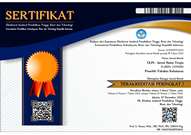The effect of microwave treatment on the color changes and wettability of sembilang bamboo (Dendrocalamus giganteus Munro)
Abstract
Bamboo has the potential to be a substitute for wood, although it is no exception that bamboo has many weaknesses. Bamboo is a plant with fast growth, short recycling times, and the potential to be used as structural and non-structural materials. Sembilang bamboo is a bamboo that has a large diameter and is commonly known as giant bamboo. Poor adhesive dispersion was a problem in previous studies, and the presence of discoloration due to important treatments was known. Heating using a microwave is a step in this research to solve the problems that occur. The research was carried out by measuring bamboo samples of a certain size, then the bamboo was scanned, and the wettability was measured initially and at the end of the test. Bamboo samples were heated in the microwave at a certain temperature of 60–75°C for 0.5–1 minute. The results of the 1 minute and 0.5 minute microwave treatment tests can increase wettability so that the spread becomes longer, with a small K value of 0.391. This is presumably because the contact angle is less than 90°. In addition, the treatment also had a small and moderate effect on the color differences that occurred.
Keywords
Full Text:
PDFReferences
Burtin P, Jay-Allenand C, Charpentier JP and Janin G. 2000. Modification of hybrid walnut (Juglans nigra 23 x Juglans regia) wood colour and phenolic composition under various steaming condition. Holzforschung 54(1): 33-38.
https://doi.org/10.1515/HF.2000.006
Cahyono TD, Wahyudi I, Priadi T, Febrianto F, and Ohorella S. 2017. Sudut Kontak dan Keterbasahan Dinamis Kayu Samama pada Berbagai Pengerjaan Kayu. Jurnal Teknik Sipil 24(3): 209-216. https://doi.org/10.5614/jts.2017.24.3.3
Febrianto F, Sumardi I, Hidayat W, Maulana S. 2017. Papan Untai Bambu Berarah Material Unggul Untuk Komponen Bangunan Struktur. IPB Press, Bogor (ID), p. 159.
Hakkou M, Pétrissans M, Zoulalian A, Gerardin P. 2005. Investigation of wood wettability changes during heat treatment on the basis of chemical analysis. Polym. Degrad. Stabil. 89 (1): 1–5. https://doi.org/10.1016/j.polymdegradstab.2004.10.017
Hse CY. 1972. Wettability of southern pine by phenol formaldehyde wood adhesive. Forest Product Journal 22(1): 51-56. https://www.fs.usda.gov/research/treesearch/24148. 03 Agustus 2023.
Kementerian Lingkungan Hidup dan Kehutanan. 2016. Statistik KLHK 2016. Jakarta (ID). Kementerian Lingkungan Hidup dan Kehutanan. Indonesia.
Laskowska A and Kozakiewicz P. 2017. Surface wettability of wood species from tropical and temperate zones by polar and dispersive liquids. Drvna Industrija 68(4): 299-306. https://doi.org/10.5552/drind.2017.1704
Lestari AT, Darmawan iw, dan Nandika D. 2016. Pengaruh Kondisi Permukaan terhadap Daya Lekat Lapisan Pelindung. J. Ilmu Teknol. Kayu Tropis 14(1): 11-22.
https://doi.org/10.51850/jitkt.v14i1.7.g7
Lu JZ and Wu Q. 2006. Surface Characterization of Chemically Modified Wood: Dynamic Wettability. Wood and Fiber Science, 38(3):497-511. https://wfs.swst.org/index.php/wfs/article/view/1488. 03 Agustus 2023.
Monni J, Alvila L, Pakkanen TT. 2007. Structural and physical changes in phenol-formaldehyde resol resin, as a function of the degree of condensation of the resol solution. Industrial & Engineering Chemistry Research 46(21):6916-6924. https://doi.org/10.1021/ie070297a
Muflihati, Nawawi DS, Rahayu IS, and Syafii. 2014. Perubahan Warna Kayu Jabon Terwarnai Ekstrak Kulit Kayu Samak (Syzygium inophyllum). J. Ilmu dan Teknologi Kayu Tropis 12(1): 11-19. https://doi.org/10.51850/jitkt.v12i1
Prosea. 1995. Plant Resources of South-East Asia 7. Bamboos. Prosea Foundation, Bogor (ID).
Shi SQ and Gardner DJ. 2001. Dynamic adhesive wettability of wood. Wood and Fiber Science 33(1):58-68.
https://wfs.swst.org/index.php/wfs/article/view/538. 03 Agustus 2023.
Tang L, Zhang R, Zhou X, Pan M, Chen M, Yang X, Zhou P, and Chen Z. 2012. Dynamic adhesive wettability of poplar veneer with cold oxygen plasma treatment. BioResources, 7(3):3327-3339. https://doi.org/10.15376/biores.7.3.3327-3339
T Li, Chenga D-l, Magnus EP, Walinder B, and Zhoua DG. 2015. Wettability of oil heat-treated bamboo and bonding strength of laminated bamboo board. Industrial Crops and Products 69: 15–20. https://doi.org/10.1016/j.indcrop.2015.02.008
Wang JY and Cooper PA. 2005. Effect of oil type: temperature and time on moisture properties of hot oil-treated wood. Holz Roh Werkst. 63: 417–422. https://doi.org/10.1007/s00107-005-0033-4
Widjaja EA, Rahayuningsih Y, Ubaidillah R, Maryanto I, dan Rahajoe JS. 2014. Kekinian keanekaragaman hayati Indonesia 2014. LIPI Press, Jakarta (ID), p.344
Ying SC. 1996. Wood Science. China Forestry Publishing House. Beijing, China. https://www.abebooks.com/Wood-Science-2Chinese-Edition-LIU-XING/10565739862/bd. 03 Agustus 2023.
Yuan Y and Lee TR. 2013. Contact angle and wetting properties, Surface Science Techniques. Springer: 3-34. https://link.springer.com/chapter/10.1007/978-3-642-34243-1_1. 03 Agustus 2023.
DOI: http://dx.doi.org/10.32522/ujht.v8i1.12344
Refbacks
Copyright (c) 2024 Rynaldo Davinsy, Istie Sekartining Rahayu

This work is licensed under a Creative Commons Attribution-ShareAlike 4.0 International License.
Ulin : Jurnal Hutan Tropis |
Forestry Faculty of Mulawarman University Jl. Penajam Kampus Gunung Kelua Samarinda 75123 E-Mail: ulin.jhuttrop@fahutan.unmul.ac.id |
Support Contact Lisa Andani |
|



